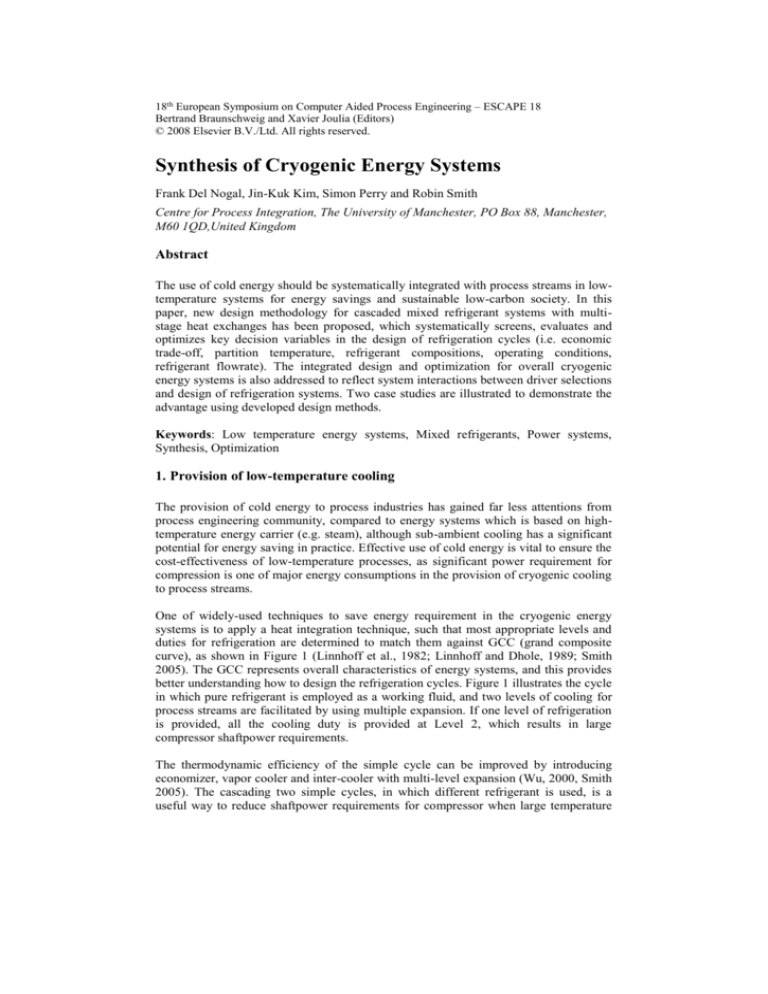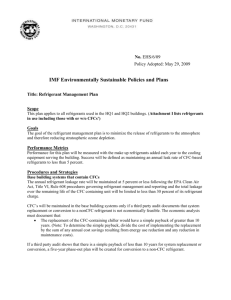
18th European Symposium on Computer Aided Process Engineering – ESCAPE 18
Bertrand Braunschweig and Xavier Joulia (Editors)
© 2008 Elsevier B.V./Ltd. All rights reserved.
Synthesis of Cryogenic Energy Systems
Frank Del Nogal, Jin-Kuk Kim, Simon Perry and Robin Smith
Centre for Process Integration, The University of Manchester, PO Box 88, Manchester,
M60 1QD,United Kingdom
Abstract
The use of cold energy should be systematically integrated with process streams in lowtemperature systems for energy savings and sustainable low-carbon society. In this
paper, new design methodology for cascaded mixed refrigerant systems with multistage heat exchanges has been proposed, which systematically screens, evaluates and
optimizes key decision variables in the design of refrigeration cycles (i.e. economic
trade-off, partition temperature, refrigerant compositions, operating conditions,
refrigerant flowrate). The integrated design and optimization for overall cryogenic
energy systems is also addressed to reflect system interactions between driver selections
and design of refrigeration systems. Two case studies are illustrated to demonstrate the
advantage using developed design methods.
Keywords: Low temperature energy systems, Mixed refrigerants, Power systems,
Synthesis, Optimization
1. Provision of low-temperature cooling
The provision of cold energy to process industries has gained far less attentions from
process engineering community, compared to energy systems which is based on hightemperature energy carrier (e.g. steam), although sub-ambient cooling has a significant
potential for energy saving in practice. Effective use of cold energy is vital to ensure the
cost-effectiveness of low-temperature processes, as significant power requirement for
compression is one of major energy consumptions in the provision of cryogenic cooling
to process streams.
One of widely-used techniques to save energy requirement in the cryogenic energy
systems is to apply a heat integration technique, such that most appropriate levels and
duties for refrigeration are determined to match them against GCC (grand composite
curve), as shown in Figure 1 (Linnhoff et al., 1982; Linnhoff and Dhole, 1989; Smith
2005). The GCC represents overall characteristics of energy systems, and this provides
better understanding how to design the refrigeration cycles. Figure 1 illustrates the cycle
in which pure refrigerant is employed as a working fluid, and two levels of cooling for
process streams are facilitated by using multiple expansion. If one level of refrigeration
is provided, all the cooling duty is provided at Level 2, which results in large
compressor shaftpower requirements.
The thermodynamic efficiency of the simple cycle can be improved by introducing
economizer, vapor cooler and inter-cooler with multi-level expansion (Wu, 2000, Smith
2005). The cascading two simple cycles, in which different refrigerant is used, is a
useful way to reduce shaftpower requirements for compressor when large temperature
2
Frank Del Nogal et al.
range is to be covered by refrigeration. Another important degree of freedom for energy
saving in refrigeration system is the decision for how to reject heat to or remove heat
from process stream(s). These considerations often lead to have a complex cycle with
multi-levels and/or cascaded arrangement, which consists of large number of unit.
T*
Level 1
Q1
Level 1
W
Q2
Level 2
Level 2
Q1
(A)
H
Q2
(B)
Figure 1. Refrigeration with pure refrigerant
The use of mixed refrigerants in the cycle can simplify the structure of refrigeration
cycle as well as reduce compression duty significantly. As illustrated Figure 2a, the
close match between hot (process) stream and cold (refrigeration) stream can be
achieved by using mixed refrigerant, while pure refrigerant cannot avoid
thermodynamic inefficiency due to large gap existed between two streams. The shape of
refrigeration stream in Figure 2a depends on the composition of refrigerants and its
operating conditions. When large temperature range is to be cooled by mixed refrigerant
systems, cascade arrangement is also possible (Figure 2b). Other structural variations to
obtain a better match between hot and cold stream profiles had been suggested, for
example, repeated partial condensation and separation of the refrigerant stream (Finn et
al., 1999), and a self-cooling mixed refrigerant cycle (Walsh, 1993).
T
Process stream
T
Process stream
Upper
cycle
Pinch Point
Evaporator
(mixed refrigerant)
Partition
temperature
Lower
cycle
Evaporator (pure refrigerant)
H
H
(A)
(B)
Figure 2. Mixed refrigerant systems
In order to explore the advantages from mixed refrigerant systems, it is aimed to
develop a systematic design and optimization framework for mixed refrigerant systems,
in which design interactions are systematically investigated, as well as all the available
structural and operating options are fully screened to provide optimal and economic
design. The developed new design method also overcomes shortcomings which had not
Synthesis of Cryogenic Energy Systems
3
been fully addressed in previous works done by Lee (2001) and Vaidyaraman and C.
Maranas (2002):
i)
ii)
iii)
iv)
enforcement of minimum temperature difference (Tmin) throughout the
heat recovery
systematic trade-off between capital and operating cost
multi-stage compression with inter-cooling, and
avoiding being trapped in local optima.
2. Optimization of Mixed Refrigerant Systems
Mixed refrigerant systems are optimized with the superstructure shown in Figure 3. The
superstructure used in this work is arranged with multi-stage heat exchangers in which
mixed refrigerant cycle provides not only cooling for a process stream, but also cooling
of a hot gas stream. The liquid refrigerant is separated from hot refrigerant stream, and
this can be further subcooled in the exchanger before expansion or can be expanded
without subcooling. Both cases can be considered within the superstructure proposed in
the study.
The complexity of the multi-stage arrangement is further increased by introducing
cascading of two cycles. The composition of refrigerants and operating conditions for
each cycle can be chosen differently, which provides great flexibility in the design as
the cooling profile can be closely matched with process stream. The heat recovery is
integrated between upper and lower cycles. It should be noted that economic trade-off
should be made to justify gains obtained from complex structures at the expense of
capital cost.
.....
Process Stream
Figure 3. Superstructure for cascaded mixed refrigerant systems
The key optimization variables in the design are: flowrate and composition of mixed
refrigerants for each cycle, intermediate temperature between stages for each cycle, and
operating pressures of stream after and before compressor for each cycle. The
optimization formulation includes:
Objective function
4
Frank Del Nogal et al.
Material and energy balances for each stage
Pressure, temperature and enthalpy profiles
Multistage compression arrangement with inter-cooling
The developed optimization is solved with genetic algorithm as the previous study
based on deterministic optimization techniques showed that it is often trapped in local
optima, due to highly non-linear nature of formulations in the model. The simulation
model and genetic algorithm is interacted to produce high quality optimal solution(s),
although computational time is relatively expensive.
It should be mentioned that one of important features in the developed model is to
ensure feasibility of heat recovery in every exchanger. The potential candidate (design)
produced during optimization, is simulated, and cold and hot composite curves are
produced. Then this is rigorously checked against given Tmin.
3. Case study 1
First case study is to liquefy gas stream from 25 oC to -163 oC by single mixed
refrigerant cycle with a single stage. The energy data for process stream is given in
Figure 4. The objective function is to minimize the shaftpower demand for
compression. When 5 oC of Tmin is considered, the optimal cooling systems with 27.8
MW of minimum power demand are given in Figure 4, in which compositions of
refrigerants and operating conditions (flowrate, pressure) are shown as well. The
comparison between Lee’s (2001) method and new method is made, which shows 8 %
of improvement in power demand from new method.
30 oC
2.81 kmol/s
45.1 bar
1.8 bar
Process
Stream
25 oC
-163 oC
N2 14.5 %
C1 19.5 %
C2 39.3%
C3 0.04%
n-C 4 26.67 %
Temp ( oC) H (MW)
25
-6
-57.7
-74.6
-96.5
-163
20.2
18.3
14.5
10.2
5.9
0
Figure 4. Case study 1: Optimal design for single mixed refrigerant systems
4. Case study 2: Integrated design for low-temperature energy system with
driver selection
The second case study is to cool gas stream from 35 oC to -160 oC, and the detailed
energy flow is given in Figure 5. In this example, cascade mixed refrigerant systems is
optimized with 3 oC of Tmin.
Synthesis of Cryogenic Energy Systems
5
As low-temperature energy systems employs a series of compressor, the driver selection
(i.e. matching between mechanical power demands and available direct drivers) is very
important in the overall system design. The design of refrigeration systems (i.e. number
of compressor and its duty) inevitably affects the driver selection, and therefore, an
integrated design between refrigeration and driver selection should be made. The
simultaneous optimization between two design problems are carried out, which provides
more realistic and applicable design. (Figure 6)
The optimized variables are shown in the Figure 5, at the minimum power demand with
216.06 MW. It should be noted that the design results from an integrated optimization
of overall low-temperature energy systems, with the full consideration of driver
selections. It is clearly illustrated that the composition and operating conditions per each
cycle are optimized to serve for each operating range. One stage for each cycle is
chosen in this case, as multi-stage arrangement is not favored, due to large capital
expenditure.
F = 20.3 kmol/s
N2 0.1 %
C1 9.8 %
C2 41.6 %
C3 11.8 %
n-C 4 37.3 %
37.3 bar
4 bar
35 oC
Process
Stream
Temp ( oC) H (MW)
35
4.5
-21.9
-54.0
-80.0
-131.4
-160.0
42.2 bar
212
186
158
120
65
22
0
F = 12.9 kmol/s
N2 11.1 %
C1 40.1 %
C2 35.3 %
C3 13.0 %
n-C4 0.5 %
1.9 bar
-160 oC
Figure 5. Case study 2: Optimal design for cascade mixed refrigerant systems
Genetic
Algorithm
Objective
function
Set of operating
conditions with
structural options
Refrigeration
simulator
Updated power
demands
Driver selection
Integrated design
Figure 6. Integrated design for low-temperature energy systems
6
Frank Del Nogal et al.
5. Summary
The developed new synthesis method for mixed refrigeration system provides not only
energy saving in cryogenic systems but also conceptual understanding of the design
problem in cold energy management. The effective way for providing cold energy is
exploited from cascaded multi-stage mixed refrigeration cycles, which can be very
effective to reduce compression power in low-temperature systems. Also the integrated
design of refrigeration and driver selection is also developed and discussed from the
case study.
References
A. Finn, G. Johnson and T. Tomlinson (1999) Developments in Natural Gas
Liquefaction, Hydrocarbon Processing, 78 (4)
G. Lee (2001) Optimal design and analysis of refrigeration systems for low temperature
processes, PhD Thesis, UMIST, Department of Process Integration, Manchester, UK
B. Linnhoff and V. Dhole (1989) Shaftwork Targeting for Subambient Plants, AIChE
Spring Meeting, Houston, US
B. Linnhoff, D. Townsend, D. Boland, G. Hewitt, B. Thomas, A. Guy and R. Marsland
(1982) User Guide on Process Integration for the Efficient Use of Energy. IChemE:
Rugby, England, 1982
R. Smith (2005) Chemical Process Design and Integration, John Wiley & Sons, Ltd.,
UK
S. Vaidyaraman and C. Maranas (2002) Synthesis of Mixed Refrigerant Cascade
Cycles, Chemical Engineerng Communications, 189 (8)
B. Walsh (1993) Mixed Refrigerant Process Design, Off. Proc. Comb. Conf., 6th Conf.
Asia Pac. Confederation. Chemical Engineering, 1, 59/1-64/1
G. Wu (2000) Design and Retrofit of Integrated Refrigeration Systems, PhD Thesis,
UMIST, Manchester, UK









